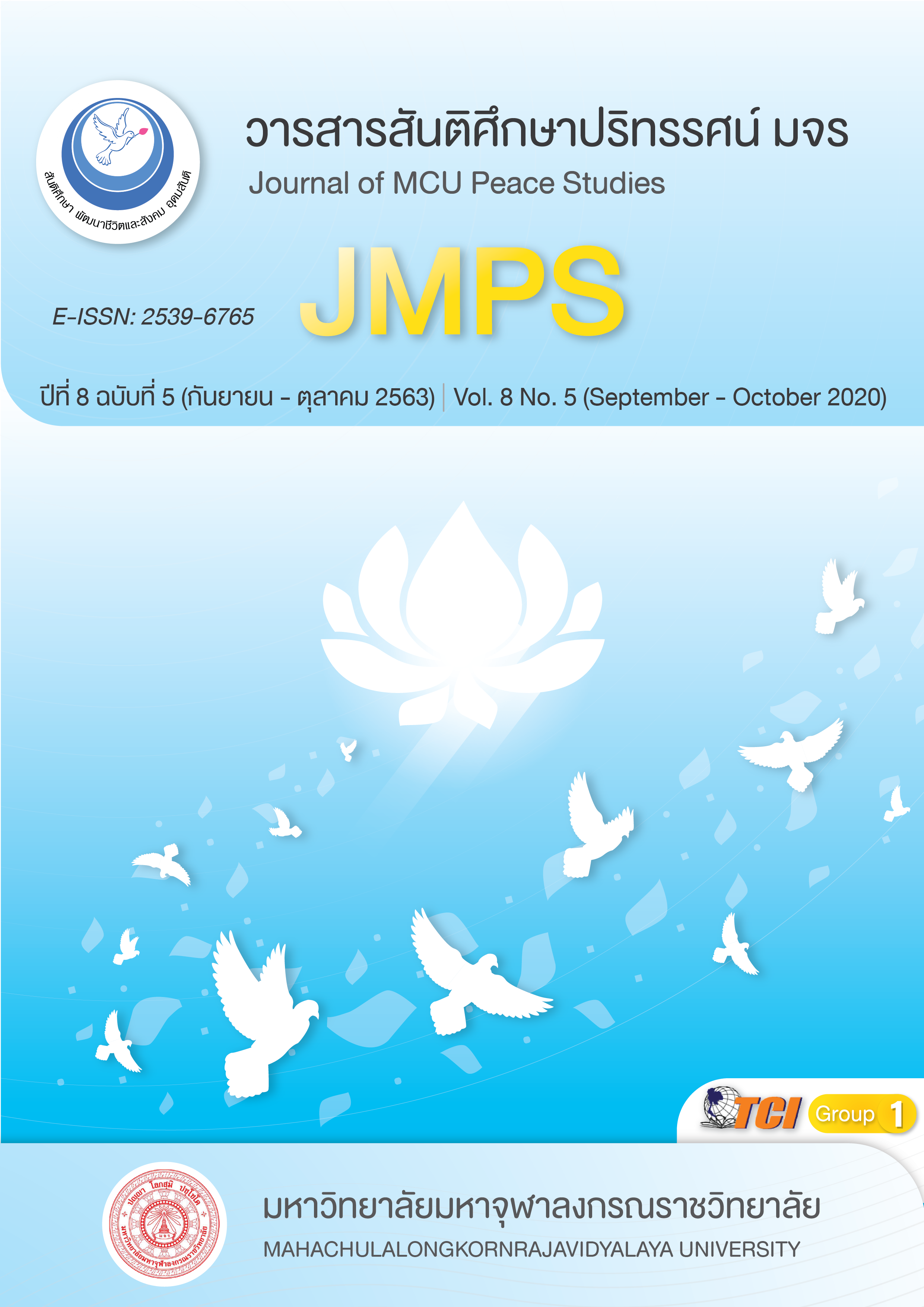รูปแบบการบริหารจัดการการเสริมสร้างคุณธรรมด้านจิตอาสา ของนักเรียนนักศึกษา วิทยาลัยอาชีวศึกษา สังกัดสำนักงานคณะกรรมการการอาชีวศึกษา
Main Article Content
บทคัดย่อ
บทความวิจัยครั้งนี้ มีวัตถุประสงค์เพื่อ 1) สร้างรูปแบบการบริหารจัดการการเสริมสร้างคุณธรรมด้านจิตอาสาของนักเรียนนักศึกษา วิทยาลัยอาชีวศึกษา สังกัดสำนักงานคณะกรรมการการอาชีวศึกษา 2) ประเมินรูปแบบการบริหารจัดการเสริมสร้างคุณธรรมจิตอาสาของนักเรียนนักศึกษา วิทยาลัยอาชีวศึกษา สังกัดสำนักงานคณะกรรมการการอาชีวศึกษา ที่พัฒนาแล้ว โดยดำเนินการวิจัย 2 ขั้นตอน ได้แก่ ขั้นตอนที่ 1 การสร้างรูปแบบฯ โดยการศึกษาสภาพการบริหารจัดการการเสริมสร้างคุณธรรมด้านจิตอาสาของนักเรียนนักศึกษา วิทยาลัยอาชีวศึกษา ด้วยการศึกษาเอกสาร และใช้แบบสอบถาม ผู้บริหาร ครู บุคลากรทางการศึกษา จำนวน 357 คน และการสัมภาษณ์เชิงลึกผู้อำนวยการสถานศึกษา จำนวน 9 คน และตรวจสอบรูปแบบฯ โดยนำข้อมูลที่ได้มายกร่างและตรวจสอบความเหมาะสม ความถูกต้อง ครอบคลุม โดยการสัมภาษณ์เชิงลึกผู้เชี่ยวชาญ จำนวน 9 คน ขั้นตอนที่ 2 ประเมินรูปแบบฯ โดยทดลองใช้กับสถานศึกษา 2 แห่ง และประเมินเพื่อตรวจสอบความเป็นประโยชน์และความเป็นไปได้ในการทำรูปแบบไปใช้ด้วยแบบตรวจสอบรายการ ผลการวิจัยพบว่า รูปแบบการบริหารจัดการการเสริมสร้างคุณธรรมด้านจิตอาสาของนักเรียนนักศึกษา วิทยาลัยอาชีวศึกษา สังกัดสำนักงานคณะกรรมการการอาชีวศึกษา มี 3 องค์ประกอบหลัก ได้แก่ 1) คุณธรรมด้านจิตอาสา ประกอบด้วย คุณธรรมจิตอาสาด้านการรับรู้ คุณธรรมจิตอาสาด้านเจตคติ และคุณธรรมจิตอาสาด้านพฤติกรรม 2) กระบวนการบริหารตามวงจรคุณภาพเดมมิง PDCA ประกอบด้วย การวางแผน การลงมือปฏิบัติ การตรวจสอบ และการปรับปรุงแก้ไข 3) ปัจจัยส่งเสริมการเสริมสร้างคุณธรรมด้านจิตอาสาของนักเรียนนักศึกษา ประกอบด้วย การกำหนดนโยบาย การมีผู้นำที่เป็นแบบอย่าง การสร้างความรู้ความเข้าใจ ส่งเสริมการมีส่วนร่วม และการติดตามและประเมินผลอย่างต่อเนื่อง จากผลการทดลองใช้และ ประเมินรูปแบบที่พัฒนาขึ้น พบว่า มีความเป็นประโยชน์และความเป็นไปได้อยู่ในระดับมากที่สุด ( = 4.74, S.D.= .44) และ (
= 4.62, S.D.= .47)
Article Details
ทัศนะและความคิดเห็นที่ปรากฏในบทความในวารสาร ถือเป็นความรับผิดชอบของผู้เขียนบทความนั้น และไม่ถือเป็นทัศนะและความรับผิดชอบของกองบรรณาธิการ ยินยอมว่าบทความเป็นลิขสิทธิ์ของวารสาร
เอกสารอ้างอิง
Bloom, B. S. (1980). Taxonomy of Educational Objectives, Handbook I: Cognitive Domain. New York: David Mokay.
Bua-son, R. (2007). Project Management: Guidelines for Success. (3rd edition). Bangkok: Chulalongkorn University Press.
Deming, W. (1986). Out of the Crisis. Massachusetts Institute of Technology, Center for Advanced Engineering Study.
Likert, R. (1967). “The Method of Constructing and Attitude Scale”. In Reading in Fishbeic, M (Ed.), Attitude Theory and Measurement. New York: Wiley & Son.
Ministry of Education, Office of the Vocational Education Commission. (2017). Vocational development development plan 2017-2036. Bangkok: Office.
Muangkaew, S., & Sakonkiet, W. (2016, January-June). A model of volunteer development in non-profit organization for children and youth. Journal of Doctor of Philosophy Program in Social Sciences Ramkhamhaeng University. 1(1), 115-133.
National Economic and Social Development Board. (2017). 12th National Economic and Social Development Plan (2017-2021). Bangkok: Office.
Office of Vocational Education Commission. (2009). Vocational education standards. Bangkok: Office.
Oui-Nong, N. (2003). Research report on public awareness of the community. A case study of educational management at the Border Patrol Police School. Bangkok: Educational research project with the community.
Phanthumnavin, D. (1995). Work ethics. Bangkok: Thai Wattana Panich Publishing.
Phimphisai, Y. (2012). Study of problems and solutions of controversy of vocational students in Bangkok and Metropolitan. Bangkok: Don Mueang Technical College.
Pratumtri, N. (2012). Development of Public Mental Indicators for Catholic School Students in the Northeast. (Doctoral Dissertation). Graduate School: Wongchawalitkul University.
Sai-Kaew, S. (2003). Public Consciousness, Formation and Strengthening Process. Phetchaburi Wittaya Journal. 4(1), 38-39.
Sathapornbamrungpao, P. et al. (2017). Guidelines for the development of factors affecting student volunteers Institute of vocational education in the northeastern region 5. Research community journals. 11(3), 110-125.
PengSawat, V. (2010). Research and development. Journal of Sakon Nakhon Rajabhat University. 2(4), 1-15.
Si Sa-at, B. (2010). Thesis control model. Institute of Research and Development of Teaching and Learning. Maha Sarakham: Srinakharinwirot University, Maha Sarakham.
Singhapol, S. (1999). Must teach new awareness. Sima Charn Journal. 13(27), 15-16.
Songkiatkun, N. (2017). Preventive measures to resolve the controversy of vocational students in Bangkok and metropolitan. Journal of Social Studies Review. 19(2), 63-81.
Sriboriboon, N. (2007). Development of Causal Model of Volunteer Spirit of Upper Secondary School Students. In schools under the Office of the Basic Education Commission. Ba ngkok: Chulalongkorn University.
PhalaSuek, R. (2010). Development of Desirable Graduate Characteristics of Nursing Graduates Under the Ministry of Public Health. (Master’s Thesis). Graduate School : Nakhon Si Thammarat Rajabhat University. Nakhon Si Thammarat.
Suthirat, T. (2007). Attitude Toward Interpretation between Institutional Vocational Students. (Master’s Thesis). Graduate School: Thammasat University. Bangkok.
Wasi, P. (1998). National Strategy. For economic strength and morality. Bangkok: Villager doctor.
Watthanasiritham, P., & Sunjorn, S. (2000). Desirable Thai Consciousness. Bangkok: Rural Reconstruction Foundation of Thailand.


